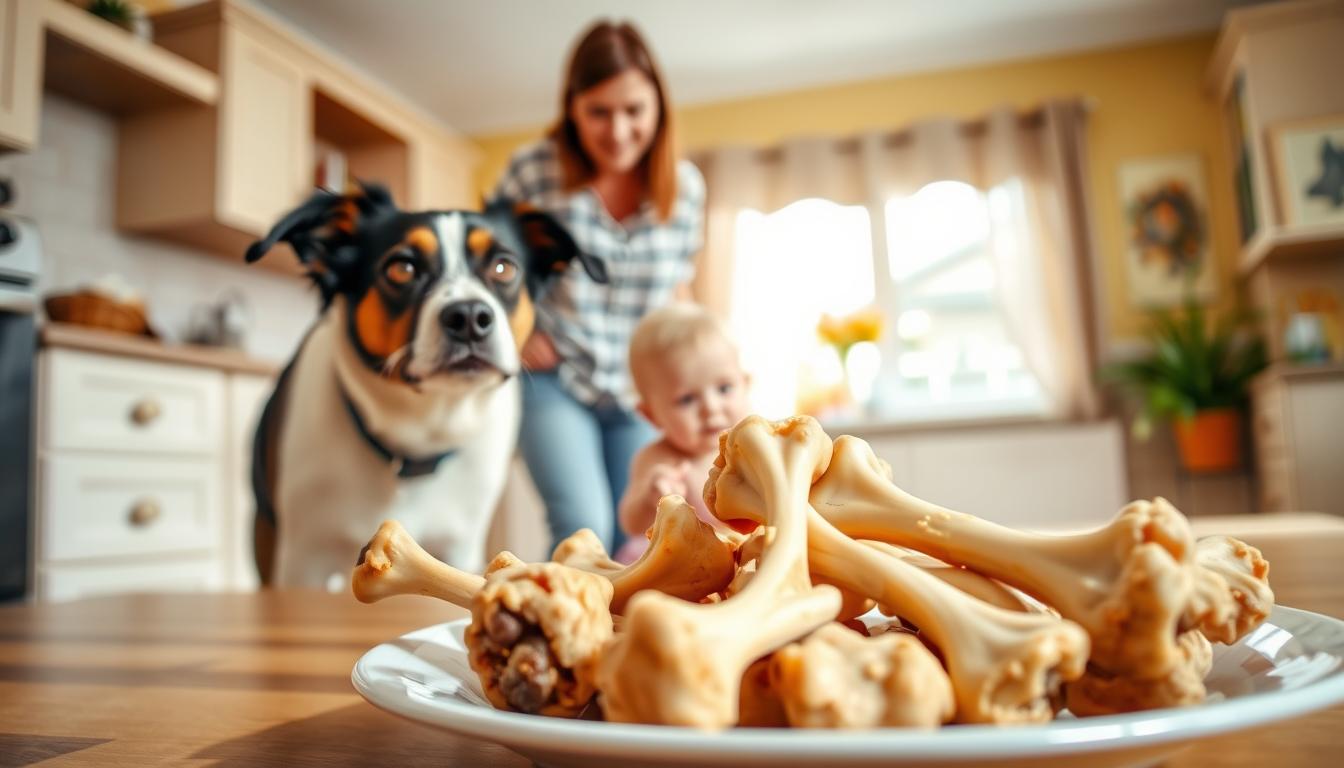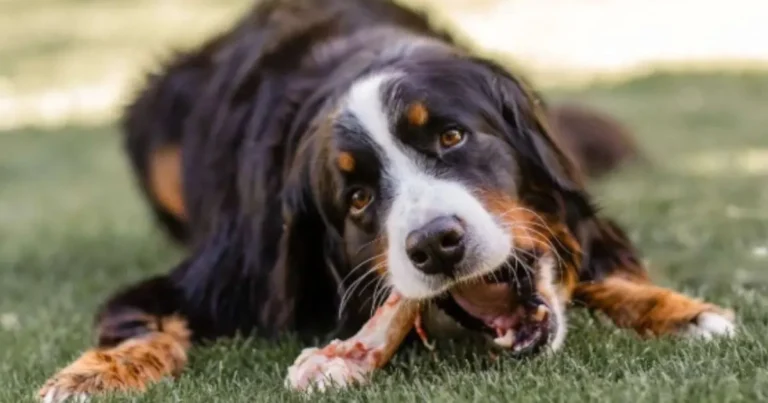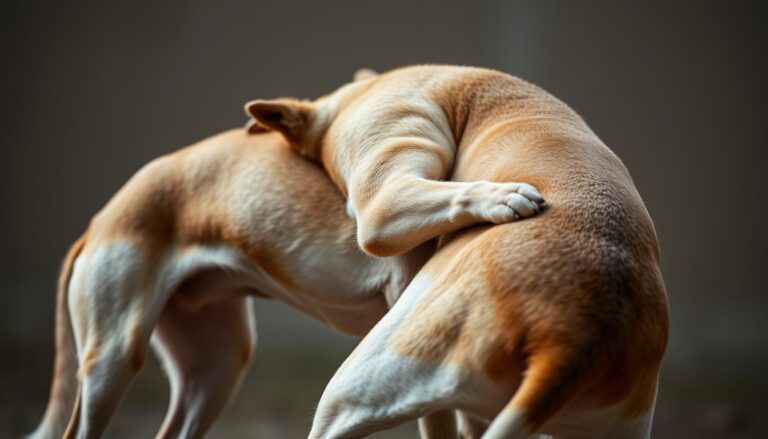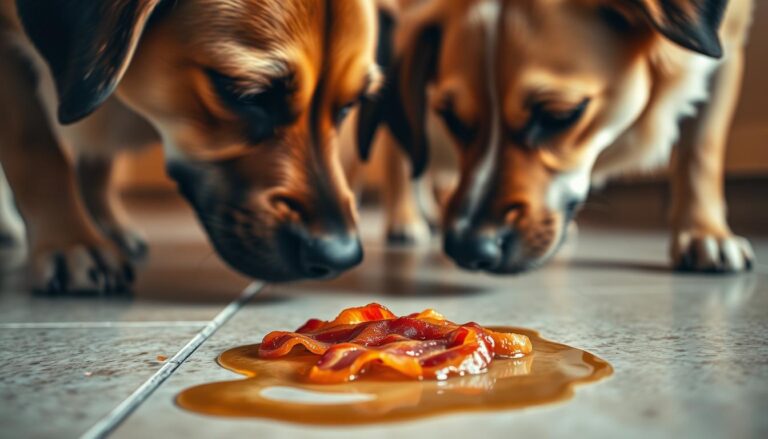Dogs Eating Chicken Bones: Risks and Safety Tips
Every dog owner knows that moment of panic when your furry friend suddenly grabs something they shouldn’t. Dogs eating chicken bones can send shivers down any pet parent’s spine, triggering an instant mix of worry and concern about potential health risks.
Your canine companion’s natural curiosity often leads them to explore food scraps, but understanding the safety of dogs eating chicken bones is crucial. While the temptation to share table scraps might seem harmless, certain bone types can pose serious health dangers.
Veterinary experts consistently warn about the risks associated with dogs consuming chicken bones. Can dogs eat chicken bones safely? The short answer is no. Cooked chicken bones are particularly dangerous, as they can splinter and cause internal injuries that may require immediate medical attention.
This guide will walk you through everything you need to know about protecting your dog from potential bone-related health complications. From understanding the risks to learning prevention strategies, you’ll gain essential knowledge to keep your four-legged friend safe and healthy.
Table of Contents
Understanding the Dangers of Dogs Eating Chicken Bones
Dog owners need to know the dangers of chicken bones. These bones can harm your pet’s health in many ways. It’s not just about choking.
It’s important to know the difference between various bones and their risks.
Cooked vs Raw Chicken Bone Risks
Cooked chicken bones are very dangerous for dogs. They become brittle and can break into sharp pieces. These pieces can hurt your dog’s internal organs.
Raw chicken bones are different. They are softer and less likely to splinter. But, they can still cause choking and may carry harmful bacteria.
Internal Damage Potential
The biggest danger of chicken bones is the risk of internal injuries. Sharp bone fragments can:
- Puncture the digestive tract
- Block the intestines
- Lead to serious stomach problems
| Bone Type | Splintering Risk | Injury Potential |
|---|---|---|
| Cooked Chicken Bones | High | Extreme |
| Raw Chicken Bones | Low | Moderate |
Common Complications from Bone Ingestion
Knowing the dangers of chicken bones means understanding serious health issues. These can include internal bleeding, long-term digestive problems, and even life-threatening surgeries.
Vets advise against giving chicken bones to dogs. It’s better for your pet’s health and can save you money on vet bills.
Immediate Actions When Your Dog Swallows Chicken Bones
Seeing your dog swallow chicken bones can be very stressful. It’s important to act fast to avoid health problems.
Stay calm when your dog swallows chicken bones. Panicking can lead to bad decisions. Follow these important steps:
- Check for immediate choking signs
- Do not attempt to induce vomiting
- Keep your dog calm and restrict movement
- Avoid giving any over-the-counter medications
Watching your dog closely is key after they eat chicken bones. Look for signs like:
- Difficulty breathing
- Excessive drooling
- Repeated gagging
- Visible discomfort
Your vet might suggest a bland diet if your dog is okay. This could be boiled chicken and rice. It helps the bones move through their system.
If you see any bad symptoms, call your vet right away for help.
Preventing problems is always best. Knowing what to do if your dog swallows chicken bones helps keep them safe.
Signs and Symptoms to Watch For After Bone Ingestion
When your dog eats a chicken bone, watching them closely is key. Spotting symptoms early can stop serious problems and might save your pet’s life.
Vets stress the need to watch your dog closely after they eat a bone. The first 24 hours are especially important for spotting health risks.
Emergency Warning Signs
Get your dog to the vet right away if you see these signs:
- Severe and persistent vomiting
- Bloody stool or rectal bleeding
- Extreme lethargy or unresponsiveness
- Significant abdominal pain or swelling
- Difficulty breathing or choking
Non-Emergency Symptoms to Monitor
Watch for these milder symptoms but don’t rush to the vet:
- Mild gagging or occasional coughing
- Reduced appetite
- Slight changes in bowel movements
- Mild discomfort when walking
Timeline of Potential Complications
Symptoms can show up at different times:
- 0-6 hours: Initial digestive troubles
- 6-12 hours: Signs of internal irritation may start
- 12-24 hours: Risk of blockage or perforation grows
- 24-48 hours: Keep a close eye
If you’re unsure about your dog’s health after eating a bone, talk to your vet. They can help keep your pet safe and healthy.
Veterinary Treatment Options and Medical Care
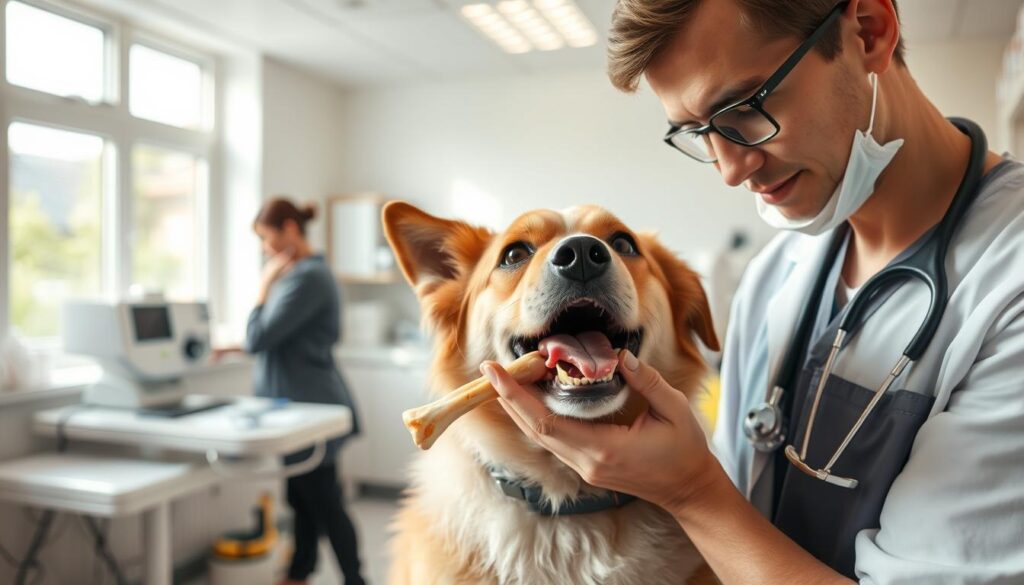
If your dog eats chicken bones, you need to see a vet fast. They can stop serious problems. Your vet will check your dog carefully to figure out the best plan.
Here’s what vets usually do for dogs with chicken bones:
- They use imaging to find where the bone is.
- They watch how your dog’s digestive system is doing.
- They might take out the bone with a special tool.
- They give your dog medical care to help them feel better.
Vets might suggest different treatments based on your dog’s situation:
| Treatment Option | Purpose |
|---|---|
| Fluid Therapy | Helps prevent dehydration and aids in recovery. |
| Specialized GI Diet | Helps protect your dog’s digestive system and aids in healing. |
| Probiotics | Helps restore your dog’s gut health and balance. |
Critical warning: Your vet will probably not give antacids. They can hide serious symptoms and make things worse.
Getting professional medical care is key. Always do what your vet tells you to help your dog get better.
Safe Alternatives to Chicken Bones for Dogs
Preventing dogs from eating chicken bones means finding safe, fun alternatives. These should meet their natural urge to chew. It’s about finding healthy options that keep their teeth clean and minds active.
Pet owners have many great choices for replacing chicken bones. These options keep dogs happy and healthy.
Dental Chews and Natural Options
- Organic dental sticks with enzymatic cleaning properties
- Vegetable-based chews promoting dental health
- Freeze-dried meat treats with minimal processing
Recommended Chew Toys
| Chew Toy Type | Benefits | Recommended For |
|---|---|---|
| Rubber Kong Toys | Durable, can be stuffed with treats | Aggressive chewers |
| Nylon Bone Chews | Long-lasting, helps clean teeth | Medium to large dogs |
| Rope Toys | Dental flossing effect, interactive | Smaller breeds |
Healthy Treat Alternatives
Here are some nutritious treats to replace chicken bones:
- Bully sticks made from natural beef muscle
- Sweet potato chews
- Carrots for low-calorie dental cleaning
- Commercially prepared dental treats
Always watch your dog while they chew. Choose the right size to avoid choking.
Prevention Strategies to Protect Your Dog
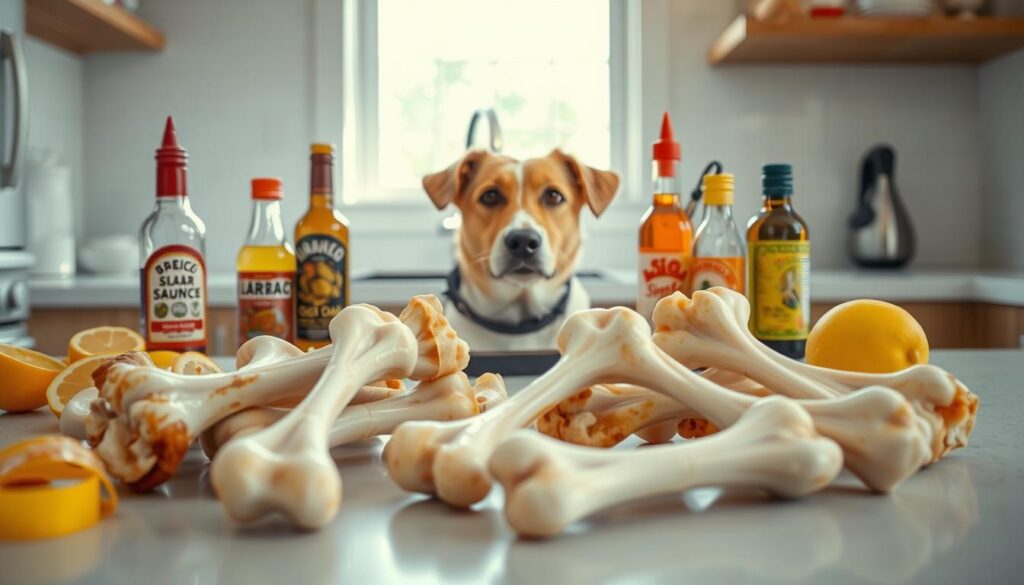
To keep your dog safe from chicken bones, you need to plan ahead and be careful. Start by making your home a safe place for your pet. Pay close attention to your kitchen and dining areas.
Here are some important steps to keep your dog safe:
- Secure trash containers with tight-fitting lids
- Clean countertops immediately after meal preparation
- Train your dog to stay away from food preparation areas
- Dispose of chicken bones in sealed bags outside the home
Chicken bones are harmful to dogs because they can splinter. This can lead to internal injuries, blockages, or damage to the digestive tract. Always supervise your dog during mealtimes and teach family members about the dangers of leaving chicken bones out.
“Prevention is always better than emergency veterinary treatment” – Veterinary Safety Experts
Keeping your kitchen safe for dogs takes effort. Set clear rules about food handling and pet boundaries. Use baby gates or designated pet-free zones during cooking to reduce risks from chicken bones.
- Keep bones out of your dog’s reach
- Use elevated surfaces during food preparation
- Educate all household members about bone dangers
Your dedication to preventing dogs from eating bones can save your pet from serious health issues.
Nutritional Considerations and Dietary Guidelines
Knowing what your dog needs is key when it comes to protein like chicken. While chicken bones are risky, chicken meat is full of good stuff when cooked right.
Chicken is packed with nutrients that keep your dog healthy. It’s a lean protein with lots of vitamins and minerals. Remember, dogs should never eat chicken bones. Instead, give them boneless, cooked chicken as part of a healthy diet.
- Protein content supports muscle development
- Rich in vitamins B6 and B12
- Contains essential amino acids
- Low in fat compared to other meat proteins
Your dog’s diet depends on their age, size, and how active they are. Consult with a veterinary nutritionist to make a meal plan that’s safe and right for them.
If your dog can’t have chicken, try these other proteins:
- Turkey
- Fish
- Beef
- Lamb
“Nutrition is the foundation of your dog’s health and longevity.” – Veterinary Nutrition Experts
Always keep your dog safe by avoiding chicken bones. Stick to boneless, cooked chicken as a healthy meal option.
Understanding Raw Food Diets and Bone Safety
Raw food diets for dogs are becoming more popular. They offer an alternative to traditional dog food. The Biologically Appropriate Raw Food (BARF) diet is a big topic in this area.
When choosing between cooked and raw chicken bones for dogs, safety is key. Raw chicken bones are different from cooked ones. They have a different structure and can pose risks.
BARF Diet Principles
The BARF diet tries to mimic how dogs ate in the wild. It uses raw, unprocessed foods. The main ideas are:
- Feeding raw meat and bones
- Incorporating fresh vegetables
- Avoiding processed commercial foods
- Promoting natural nutrient absorption
Safe Bone Handling Practices
When thinking about whether dogs can eat chicken bones safely, cleanliness is crucial. Handling raw bones needs to be done carefully to avoid bacteria.
- Purchase bones from reputable sources
- Store raw bones at proper refrigeration temperatures
- Clean preparation surfaces thoroughly
- Monitor your dog during bone consumption
Remember that while raw bones might seem more digestible, consulting with your veterinarian remains crucial before implementing any significant dietary changes for your dog.
Conclusion
Dogs eating chicken bones can be very dangerous. It’s important for pet owners to know about these risks. Being quick to act can help avoid serious problems.
Preventing accidents is key. Make sure bones are not accessible to your dog. Also, throw away food waste properly and teach others about the dangers. Regular vet visits and a safe home can also help a lot.
If your dog eats a bone, stay calm and think about what to do. Call your vet right away for advice. Every situation is different, and a vet’s help is crucial for your dog’s health.
Being a good pet owner means being ready and informed about risks. Knowing about chicken bone dangers can help your dog live a long, happy life.

